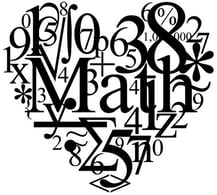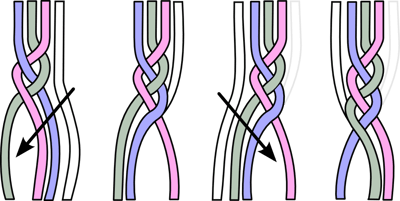
Variables, exponents, and more variables, whoo! ACT operations questions will involve all of these (and so much more!). So if you ever wondered what to do with or how to solve some of those extra long and clunky algebra problems (“What is the equivalent to ${2/3}a^2b - (18b - 6c) +$ …” you get the picture), then this is the guide for you.
This will be your complete guide to ACT operations questions—what they’ll look like on the test, how to perform operations with multiple variables and exponents, and what kinds of methods and strategies you’ll need to get them done as fast and as accurately as possible. You'll see these types of questions at least three times on any given ACT, so let's take a look.
What Are Operations?
There are four basic mathematical operations—adding, subtracting, multiplying, and dividing. The end goal for any particular algebra problem may be different, depending on the question, but the operations and the methods to solve them will be the same.
For example, when solving a single variable equation or a system of equations, your ultimate objective is to solve for a missing variable.
However, when solving an ACT operations problem, you must use your knowledge of mathematical operations to identify an equivalent expression (NOT solve for a missing variable). This means that the answer to these types of problems will always include a variable or multiple variables, since we are not actually finding the value of the variable.
Let’s look at two examples, side-by-side.
This is a single variable equation. Your objective is to find $x$.
If $(9x-9)=-11$, then $x=$?
A. $-{92/9}$
B. $-{20/9}$
C. $-{11/9}$
D. $-{2/9}$
E. $70/9$
This is an ACT operations problem. You must find an equivalent expression after performing a mathematical operation on a polynomial.
The product $(2x^4y)(3x^5y^8)$ is equivalent to:
F. $5x^9y^9$
G. $6x^9y^8$
H. $6x^9y^9$
J. $5x^{20}y^8$
K. $6x^{20}y^8$
(We will go through exactly how to solve this problem shortly)

Let's break down each component of an operations problem, step-by-step. (Also, bonus French braid lesson!)
Operation Question How-To's
Let us look at how to identify operations questions when you see them and how to solve for your answer.
How to Identify an Operations Problem
As we said before, the end goal of an operations problem is not to solve for a missing variable. Because of this, you can identify an operations problem by looking at your answer choices.
If the question involves variables (instead of integers) in the given equation and in the answer choices, then it is likely you are dealing with an operations problem. This means that if the problem asks you to identify an “equivalent” expression or the “simplified form” of an expression, then it is highly likely that you are dealing with an operations problem.
How to Solve an Operations Problem
In order to solve these types of questions, you have two options: you can either solve your problems by using algebra, or by using the strategy of plugging in numbers.
Let’s begin by looking at how algebraic operations work.
First, you must understand how to add, multiply, subtract, and divide terms with variables and exponents. (Before we go through how to do this, be sure to brush up on your understanding of exponents and integers.)
So let us look at the rules of how to manipulate terms with variables and exponents.
Addition and Subtraction
When adding or subtracting terms with variables (and/or exponents), you can only add or subtract terms that have the exact same variable. This rule includes variables with exponents—only terms with variables raised to the same power may be added together (or subtracted).
For example, $x$ and $x^2$ CANNOT be combined into one term (i.e. $2x^2$ or $x^3$). It can only be written as $x + x^2$.
To add terms with variables and/or exponents, simply add the numbers before the variable (the coefficients) just as you would add any numbers without variables, and keep the variables intact. (Note: if there is no coefficient in front of the variable, it is worth 1. $x$ is the same thing as $1x$.)
Again, if one term has an additional variable or is raised to a different power, the two terms cannot be added together.
Yes:
$x + 4x = 5x$
$10xy - 2xy = 8xy$
No:
$6x + 5y$
$xy - 2x - y$
$x + x^2 + x^3$
These expressions all have terms with different variables (or variables to different powers) and so CANNOT be combined into one term. How they are written above is as simplified as they can ever get.
Multiplication and Division
When multiplying terms with variables, you may multiply any variable term with another. The variables do not have to match in order for you to multiply the terms—the variables instead are combined, or taken to an additional exponent if the variables are the same, after multiplying. (For more on multiplying numbers with exponents, check out the section on exponents in our guide to advanced integers)
$x * y = xy$
$ab * c = abc$
$z * z = z^2$
The variables in front of the terms (the coefficients) are also multiplied with one another as usual. This new coefficient will then be attached to the combined variables.
$2x * 3y = 6xy$
$3ab * c = 3abc$
Just as when we multiplying variable terms, we must take each component separately when we divide them. This means that the coefficients will be reduced/divided with regard to one another (just as with regular division), as will the variables.
(Note: again, if your variables involve exponents, now might be a good time to brush up on your rules of dividing with exponents.)
$${8xy}/{2x} = 4y$$
$${5a^2b^3}/{15a^2b^2} = b/3$$
$${30y + 45}/5 = 6y + 9$$
 When working on operations problems, first take each component separately, before you put them together.
When working on operations problems, first take each component separately, before you put them together.
Typical Operation Questions
Though there are several ways an operations question may be presented to you on the ACT, the principles behind each problem are essentially the same—you must manipulate terms with variables by performing one (or more) of the four mathematical operations on them.
Most of the operations problems you’ll see on the ACT will ask you to perform a mathematical operation (subtraction, addition, multiplication, or division) on a term or expression with variables and then ask you to identify the “equivalent” expression in the answer choices.
More rarely, the question may ask you to manipulate an expression in order to present your equation “in terms of” another variable (e.g. “which of the following expressions shows the equation in terms of $x$?”).
Now let’s look at the different kinds of operations problems in action.
The product $(2x^4y)(3x^5y^8)$ is equivalent to:
F. $5x^9y^9$
G. $6x^9y^8$
H. $6x^9y^9$
J. $5x^{20}y^8$
K. $6x^{20}y^8$
Here, we have our problem from earlier, but now we know how to go about solving it using algebra. We also have a second method for solving the question (for those of you are uninterested in or unwilling to use algebra), and that is to use the strategy of plugging in numbers. We’ll look at each method in turn.
Solving Method 1: Algebra operations
Knowing what we know about algebraic operations, we can multiply our terms. First, we must multiply our coefficients:
$2 * 3 = 6$
This will be the coefficient in front of our new term, so we can eliminate answer choices F and J.
Next, let us multiply our individual variables.
$x^4 * x^5$
$x^[4 + 5]$
$x^9$
And, finally, our last variable.
$y * y^8$
$y^[1 + 8]$
$y^9$
Now, combine each piece of our term to find our final answer:
$6{x^9}y^9$
Our final answer is H, $6{x^9}y^9$
Solving Method 2: Plugging in our own numbers
Alternatively, we can find our answer by plugging in our own numbers (remember—any time the question uses variables, we can plug in our own numbers).
Let us say that $x = 2$ and $y = 3$ (Why those numbers? Why not! Any numbers will do—except for 1 or 0, which is explained in our PIN guide—but since we are working with exponents, smaller numbers will give us more manageable results.)
So let us look at our first term and convert it into an integer using the numbers we selected to replace our variables.
$2{x^4}y$
$2(2^4)(3)$
$2(16)(3)$
$96$
Now, let us do the same to our second term.
$3{x^5}{y^8}$
$3(2^5)(3^8)$
$3(32)(6,561)$
$629,856$
And finally, we must multiply our terms together.
$(2{x^4}y)(3{x^5}{y^8})$
$(96)(629,856)$
$60,466,176$
Now, we need to find the answer in our answer choices that matches our result. We must plug in our same values for $x$ and $y$ as we did here and then see which answer choice gives us the same result.
If you are familiar with the process of using PIN, you know that our best option is usually to start with the middle answer choice. So let us test answer choice H to start.
$6{x^9}y^9$
$6(2^9)(3^9)$
$6(512)(19,683)$
$60,466,176$
Success! We have found our correct answer on the first try! (Note: if our first option had not worked, we would have seen whether it was too low or too high and then picked our next answer choice to try, accordingly.)
Our final answer is again H, $6{x^9}y^9$
Now let us look at our second type of problem.
For all real numbers $b$ and $c$ such that the product of $c$ and 3 is $b$, which of the following expressions represents the sum of $c$ and 3 in terms of $b$?
A. $b+3$
B. $3b+3$
C. $3(b+3)$
D. ${b+3}/3$
E. $b/3+3$
This question requires us to translate the problem first into an equation. Then, we must manipulate that equation until we have isolated a different variable than the original.
Again, we have two methods with which to solve this question: algebra or PIN. Let us look at both.
Solving Method 1: Algebra
First, let us begin by translating our equation into an algebraic one.
We are told that the product of $c$ and 3 is equal to $b$. A “product” means we must multiply $c$ and 3 and so our equation looks like this:
$3c = b$
Now we are asked to find the sum of $c$ and 3. This means we must isolate $c$ so that we can add them together.
So let us first isolate $c$ by using our knowledge of algebraic operations.
$3c = b$
$c = b/3$
Now, we can sum $c$ and 3 by replacing our $c$ with $b/3$.
$c + 3$
${b/3} + 3$
Our answer matches answer choice E.
Our final answer is E.
Solving Method 2: Plugging in numbers
Alternatively, we can use our technique of plugging in numbers. Because our question deals with variables, we can choose our own numbers (so long as they follow the rules of our given information.)
We are told that the product of $c$ and 3 is equal to $b$. So let us assign a value to $c$ and use this information to find the value of $b$.
So let us say that $c = 4$. (Why 4? Why not!)
If $c = 4$, then the product of $c$ and 3 is:
$3c = b$
$3(4) = b$
$b = 12$
So, when $c$ equals 4, $b$ equals 12.
Now we must find the sum of $c$ and 3.
$3 + c$
$3 + (4)$
$7$
Now that we have found our sum, we must identify the answer choice that gives us this sum. All of our answer choices are presented to us in terms of $b$, so we will use our found value of 12 to replace $b$ for each.
As with all PIN questions, let us start with the middle answer option.
Answer choice C gives us:
$3(b + 3)$
We can tell just by looking at it that this will be far larger than 7, but we can always test this out.
$3(12 + 3)$
$3(15)$
$45$
We can eliminate answer choice C.
Just by glancing, we can see that answer choices A and B will also be larger than 12, which means we can eliminate them as well.
Let us try answer choice D.
${b + 3}/3$
${12 + 3}/3$
$15/3$
$5$
Answer choice D did not match our sum, which means we can eliminate it as well.
By process of elimination, we are left with answer choice E, but let us test it to be sure.
${b/3} + 3$
${12/3} + 3$
$4 + 3$
$7$
Success! We have found the answer choice that matches the sum we found.
Our final answer is, once again, E, ${b/3} + 3$.
As you can see, the answer to your operations questions will always be in variables and the problem will always require you to interpret and manipulate expressions with variables, but there are always multiple options for how to solve these types of problems.
 You've got the power to decide how you would like to solve and manipulate your operations problems. Magic!
You've got the power to decide how you would like to solve and manipulate your operations problems. Magic!
Strategies for Solving Operations Questions
Now that we’ve seen the types of operations questions you’ll see on the ACT, let’s review our solving strategies.
#1: Use PIN when needed (or to double-check your answer)
If you ever feel concerned that you may be going down the wrong path while manipulating your operations problems, or if you simply want to double-check your answer, it's never a bad idea to use the strategy of plugging in numbers.
Although it can take a little longer plug in your own numbers for your variables, you'll never have to fear misremembering how to manipulate your exponents, your variables, or your equations as a whole. Once you're able to use real numbers for your variables, the math will be a piece of cake.
#2: Focus on one aspect of the term at a time
It can become all too easy to lose yourself when working with multiple variables at once, especially when it comes to multiplication and division. The test-makers know this and will provide bait answers for any number of common mistakes.
In order to keep all your components organized, focus on just one piece of each expression at a time. First, look at the coefficients, then look at the variables. This will help keep all your moving pieces in order and lessen the odds of mix-ups and mistakes.
#3: Eliminate your answer options as you go
Operations problems can sometimes mess with your head, not because they are inherently difficult, but because the ACT is a marathon and your brain can get tired and confused (and lazy). This, combined with the fact that all the answer choices generally look quite similar, with only small differences—a minus sign instead of a plus sign, one coefficient difference, etc.—can lead you to select the wrong answer, even when you know what the correct one should be.
To avoid this kind of careless error (the worst kind of error!), eliminate your answer choices as you go through your problem. Know that the coefficient for your $y$ value must be 3? Immediately cross out any answer choices that give you anything other than $3y$. It may seem inefficient to solve problems this way, but it will keep your answers much more clear.
#4: Keep careful track of your negatives
Not only can it be difficult to keep track of multiple variables, but it's even easier to mix-up the proper negative and positive signs. Many students make careless errors with their negative signs and the ACT test-makers are all too aware of this. They will provide all manner of bait answers for anyone who misplaces even a single negative sign, so be very careful.
$(a+2b+3c)-(4a+6b-5c)$ is equivalent to:
A. $-4a-8b-2c$
B. $-4a-4b+8c$
C. $-3a+8b-2c$
D. $-3a-4b-2c$
E. $-3a-4b+8c$
For a problem like this, we are being asked to subtract the entire expression, $4a + 6b - 5c$, from the entire expression, $a + 2b + 3c$.
This means that the negative sign will be negating every term in the expression $4a + 6b - 5c$. So we must put a negative sign in front of each term.
$4a$ becomes $-4a$
$6b$ becomes $-6b$
$-5c$ becomes $- -5c$ or $+5c$.
Now let us put these pieces together with the first expression.
$a - 4a = -3a$
$2b - 6b = -4b$
$3c + 5c = 8c$
Our final expression will be:
$-3a - 4b + 8c$
Our final answer is E, $-3a - 4b + 8c$.
[Note: many (many!) students put a negative sign only in front of the first term in the parenthesis, which in this case the $4a$. If you had done this, you would have gotten:
$a - 4a = -3a$
$2b + 6b = 8b$
$3c - 5c = -2c$.
This would have given you answer choice C, $-3a + 8b - 2c$. Again the test-makers know this is a common error and there will always be a bait answer to tempt anyone who makes this kind of mistake.]
 Operations in the "real world." Hyuk, yuk, yuk.
Operations in the "real world." Hyuk, yuk, yuk.
Test Your Knowledge
Now that we’ve gone through the tips and tricks of operations questions, it’s time to put your knowledge to the test with more real ACT math problems.
1. Which of the following is an equivalent simplified expression for $2(4x+7)-3(2x-4)$?
F. $x+2$
G. $2x + 2$
H. $2x+26$
J. $3x+10$
K. $3x+11$
2. Which of the following expressions is equivalent to ${1/2}y^2(6x+2y+12x-2y)$?
A. $9xy^2$
B. $18xy$
C. $3xy^2 + 12x$
D. $9xy^2-2y^3$
E. $3xy^2+12x-y^3-2y$
3. $t^2-59t+54-82t^2+60t$ is equivalent to:
F. $-26t^2$
G. $-26t^6$
H. $-81t^4+t^2+54$
J. $-81t^2+t+54$
K. $-82t^2+t+54$
4. The expression $-8x^3(7x^6-3x^5)$ is equivalent to:
A. $-56x^9+24x^8$
B. $-56x^9-24x^8$
C. $-56x^18+24x^15$
D. $-56^18-24x^15$
E. $-32x^4$
Answers: H, A, J, A
Answer Explanations:
1. As always, we can solve this question using algebra or using PIN. Let us look at both ways.
Method 1: Algebra
First, we must distribute out our terms. Only afterwards will we subtract them.
Let us take each half of our expression by itself.
$2(4x + 7)$
$8x + 14$
$ -3(2x - 4)$
$-6x + 12$
(Note: keep careful track of your negatives here, especially in the second half of our expression.)
Now, we can put the two together.
$8x + 14 - 6x + 12$
$2x + 26$
We cannot go any further, as we have combined all our like terms.
Our final answer is H, $2x + 26$
Method 2: PIN
As an alternative to algebra, we can always use plugging in numbers. So let us assign our own value to $x$, which we will call 3. (Why 3? Why not!)
This means that we will replace any $x$ in our given equation with a 3.
$2(4x + 7) - 3(2x - 4)$
$2(4(3) + 7) - 3(2(3) - 4)$
$2(12 + 7) - 3(6 - 4)$
$2(19) - 3(2)$
$38 - 6$
$32$
Now, let us find the answer choice that matches with our found answer of 32, once we replace the $x$ with 3.
As usual, when using PIN, let us start with the middle answer option.
$2x + 26$
$2(3) +26$
$6 + 26$
$32$
Success! We found our answer on the first try. But remember—when using PIN, always check your other answer options to make sure there are not repeat correct answers.
We can see straightaway that answer choices F and G will be too small, since answer choice H was a match.
So let us try answer choice J.
$3x + 10$
$3(3) + 10$
$9 + 10$
$19$
This answer choice is too small and we can see just by looking that answer choice K will be too small as well (since they only differ by 1).
This means we are safe with our answer choice H, as no others produced a match.
Our final answer is H, $2x + 26$.
As we saw from earlier in the guide and from the example problem above, we can always use algebra or PIN for our operations problems. Knowing that, we will only go through one method each for the rest of our answer explanations.
2: For this problem, let us do our solve using algebra (again, we could also use PIN, but for the sake of brevity, we are only choosing one method for each problem).
We are given the equation:
${1/2}y^2(6x + 2y + 12x - 2y)$
Now, let us first make life easier by combining the like terms in the parenthesis.
$(6x + 2y + 12x - 2y)$
$(6x + 12x + 2y - 2y)$
$(18x)$
The $y$ terms cancel one another out, so we are left with only $18x$ in the parenthesis.
Now, we must multiply our $18x$ by ${1/2}y^2$. As always, when multiplying, we must multiply first the coefficients and then combine them with the combined variables. So:
${1/2}y^2 * 18x$
$(1/2) * 18 = 9$
$y^2 * x = y^2x$
Put the two together and we have:
$9y^2x$
So our final answer is A, $9xy^2$
3: Because we used algebra last time, let us try our hand at solving this question using PIN. Because we are using our own numbers, we don’t have to worry about whether or not we are matching up the right terms, or if we are combining them incorrectly; we can bypass all the mess and use numbers instead.
We have one variable, $t$, so let us say that $t = 2$. (Why 2? As always, why not!)
$t^2 - 59t + 54 - 82t^2 + 60t$
$(2)^2 - 59(2) + 54 - 82(2)^2 + 60(t)$
$4 - 118 + 54 - 328 + 120$
$-268$
Now, we must find the answer choice that matches our found answer of 102, once we replace $t$ with 2.
Let us start in the middle, with answer choice H.
$-81t^4 + t^2 + 54$
$-81(2)^4 + (2)^2 + 54$
$-81(16) + 4 + 54$
$-1296 + 58$
$-1238$
We can see just by looking that answer choice G will be too small as well ($-26 * 16 = -416$), and answer choice F will be too large (-26 * 4 = -104).
So let us try answer choice J.
$-81t^2 + t + 54$
$-81(2)^2 + 2 + 54$
$-81(4) + 56$
$-324 + 56$
$-268$
Success! And we can also see that the only difference between answer choices J and K are the coefficient in front of $t^2$ (-81 vs. -82), so we know that answer K would produce an incorrect and smaller number than answer choice J.
Our final answer is J, $-81t^2 + t + 54$
4: Because we used PIN last time, let us use algebra for this problem. Because we do not have like terms in the parenthesis, we must distribute out our expression using multiplication.
$-8x^3(7x^6 - 3x^5)$
$-8x^3(7x^6) - -8x^3(3x^5)$
And take each piece separately.
$-8x^3(7x^6)$ => $-8 * 7 = -56$ and $x^3 * x^6 = x^[3 + 6] = x^9$ (for more on this, look to the section on exponents in our advanced integers guide).
So, combined, we have:
$-56x^9$
And the other half of our expression will be the same.
$- -8x^3(3x^5)$
$8x^3(3x^5)$ => $8 * 3 = 24$ and $x^3 * x^5 = x^[3 + 5] = x^8$
So, combined, we have:
$24x^8$
Now our equation looks like this:
$-56x^9 + 24x^8$
Our final answer is A, $-56x^9 + 24x^8$
(Take care! The only difference between answer choice A and B is the negative sign. If you weren’t careful with your double negatives, you may have fallen for this bait answer.)
 Ten thousand gold stars for solving your operations problems!
Ten thousand gold stars for solving your operations problems!
The Take-Aways
Though operations problems are easy to get wrong if you’re going too quickly through the test (or trying to solve them in your head), the basic elements are the same as any problem with variables—combine like terms, keep your work organized, and use PIN if you feel overwhelmed (or simply want to double-check your answer).
You have a multitude of options for solving ACT algebra questions, so don’t be afraid to use them.
What’s Next?
Still in the mood for math? Well we've got you covered! First, take a gander at exactly what's tested on the ACT math section in order to get a feel for your strong and weak points. Next, dive right into our ACT math guides for any topic you feel you haven't quite mastered (or just any topic you want to refresh). From circles to ratios, slopes to polygons, we've got your back.
Running out of time on the ACT math section? Check out our guide on how to help maximize your avaialable time in order to get your best score possible.
Nervous about test day? Ease your mind by taking a look at what to do the night before and the day of the test.
Trying for a perfect score? Look no further than our guide to getting a perfect 36 on the ACT math, written by a perfect-scorer.
Want to improve your ACT score by 4 points?
Check out our best-in-class online ACT prep program. We guarantee your money back if you don't improve your ACT score by 4 points or more.
Our program is entirely online, and it customizes what you study to your strengths and weaknesses. If you liked this Math lesson, you'll love our program. Along with more detailed lessons, you'll get thousands of practice problems organized by individual skills so you learn most effectively. We'll also give you a step-by-step program to follow so you'll never be confused about what to study next.
Check out our 5-day free trial:
Have friends who also need help with test prep? Share this article!

Courtney scored in the 99th percentile on the SAT in high school and went on to graduate from Stanford University with a degree in Cultural and Social Anthropology. She is passionate about bringing education and the tools to succeed to students from all backgrounds and walks of life, as she believes open education is one of the great societal equalizers. She has years of tutoring experience and writes creative works in her free time.


































 Holly R.
Holly R.